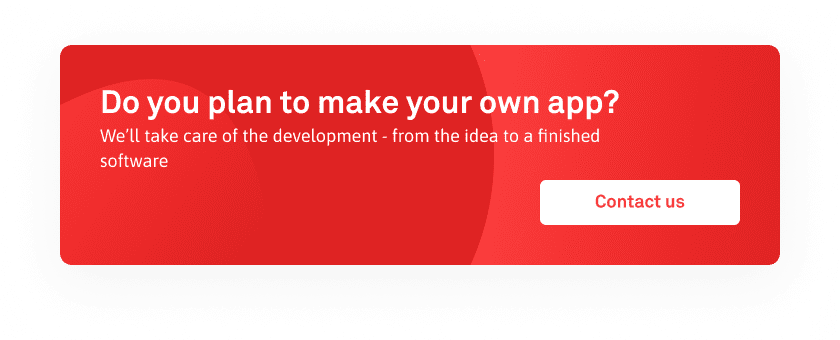[vc_row][vc_column][vc_column_text]
Building a mobile app has become one of the most innovative, profitable, and convenient moves a business can make. Even if you just have an idea for building a mobile app, you’re already on the right track to providing a quality product for app users around the world.
With over 4 million apps across the App Store and Play Store, there’s a lot of truth to the saying “there’s an app for that.” If it weren’t for people like you and me following through with their mobile app ideas, none of those apps would exist today.
One of the biggest questions we get when someone has a mobile app idea is what the process is like. While there will be a lot of stages, obstacles, and hard work to accomplish, a majority of the building of a mobile app will be done by the developers themselves.
To give you a better idea of the mobile app development process and how you can get started today, we’ll give you a step-by-step look at what you’ll be asked to do before, during, and after you hand your project off to the developers.
Let’s take a look!
Identify the problem and formulate a plan for the solution.
[ultimate_spacer height=”35″ height_on_tabs=”0″ height_on_tabs_portrait=”0″ height_on_mob_landscape=”0″ height_on_mob=”0″][/vc_column_text][/vc_column][/vc_row][vc_row][vc_column width=”1/3″][ultimate_spacer height=”35″ height_on_mob_landscape=”0″ height_on_mob=”0″][us_single_image image=”2098″ size=”full” align=”center”][/vc_column][vc_column width=”2/3″][vc_column_text]Going back to the “there’s an app for that” saying, every app will present a solution to a problem – yes, every mobile app. Even those random games we play all day are designed to solve boredom and entertain users during their downtime.
Uber solved transportation concerns, social media apps solved networking concerns, “To-Do” apps made it easier to stay organized, and the list goes on.
Once you identify the problem, it’ll help browse through your competition and view what others are doing to solve it. Being unique and offering something you can’t find elsewhere will be your best opportunity of finding success with a mobile app.[/vc_column_text][/vc_column][/vc_row][vc_row][vc_column][ultimate_spacer height=”35″][vc_column_text]
Distinguish the core features of the app.
When formulating a solution to the problem, you’ll end up with a long list of features and ideas for your mobile app. While you’ll eventually want to follow through with a majority of those features, they won’t all be necessary from the start, and some will best be suited as an update.
This is especially true for startups that are on a tight budget. Narrowing the features down to the mobile app’s core elements will help you keep costs down by limiting the amount of time spent on developing it. It’ll allow the startup to quickly release a mobile app while giving them more time to seek more funding for the updates.
If you can secure this plan before you start searching for a developer, you’ll be able to save yourself a lot of time and money in the long run.
Start designing the layout and flow of the app.
[/vc_column_text][vc_empty_space][/vc_column][/vc_row][vc_row][vc_column width=”2/3″][vc_column_text]To take the preparation stage a step further, you can start putting together your app’s design and flow. We understand that not everyone is an artist, but these don’t have to be final drafts or anything. The main goal here is to enhance the idea you’ve thought of and start bringing it to life.
The first thing you’ll want to do to build a mobile app is to create a wireframe or mockup of your mobile app. Wireframes will typically focus on the structure of the app, while mockups will give developers a glimpse of the look and feel you’re going for.
Another important deliverable in building a mobile app is flowcharts. These will generally focus on the user actions that are taking place.[/vc_column_text][/vc_column][vc_column width=”1/3″][ultimate_spacer height=”30″][us_single_image image=”2096″ size=”full”][/vc_column][/vc_row][vc_row][vc_column][ultimate_spacer height=”30″][vc_column_text]With wireframes, mockups, and flowcharts ready for your developers, you’ll already have a head-start on the UI/UX design process. All successful apps find a healthy balance between user interface and user experience, which is why these should constantly be considered throughout the design and development process.
Again, don’t be too worried about perfection here. You could write and draw everything on a napkin, as long as it’s documented. The last thing you want is to forget your amazing ideas before you get a chance to bring them to life.[/vc_column_text][/vc_column][/vc_row][vc_row][vc_column][ultimate_spacer height=”30″][vc_column_text]
Begin recruiting a qualified and reliable developer team.
By now, you have a pretty good idea of what you want in a mobile app. You know the problem, you have a solution, and you have the designs to back it up. Since most people won’t know how to build a mobile app by themselves, this is where you need the help of a developer.
The recruiting process is the most prominent part of the entire mobile app process. The decision you make in this stage will directly affect how the rest of your project goes. Ideally, you’ll find the right developer and have a smooth-sailing project. Unfortunately, many people rush through this stage and make costly errors.
To find a quality developer or team of developers, always pay attention to their past experience. Confirm they have the knowledge, skills, and creativity to bring the best out of your idea. Keep in mind that this will be your partner throughout the process, and you’ll have to be able to trust their abilities.
Most developers will have samples of past work they’ve completed, as well as testimonials from past clients. Don’t be afraid to reach out to any of their past clients to further examine how they communicate and treat their clients.
Ensure that your developer will keep in constant contact with you.
Without quality communication throughout the development process, your building of a mobile app can fall off track in the blink of an eye. Before you commit to a developer, have them confirm in writing that they’ll give you constant updates from start to finish.
This is also an excellent time to start planning ahead. Looking back at Step 2, you’ll likely already have ideas for updates, and there’s always the possibility of encountering bugs, errors, and repairs to your mobile app.
The developer you end up choosing for building a mobile app should be prepared to tag along far beyond the release of your app. Trust us, it’ll make the update stage much less frantic by saving you from having to start the recruiting process all over again.
Not to mention having a new development team spend the time to learn how your app was built — something the original developer would have no problem in recollecting.
Do You Know What Platform You’re After?
One of the things your developer will need to know before building a mobile app is whether it’ll be released on the App Store, Play Store, or both. Again, most startups will be on a tight budget, meaning they’ll likely be after a native app (single platform).
Deciding on which one is best for your app will come down to five main factors — audience, time to market, budget, monetization, and features. Let’s take a closer look at each of those:
- Audience – Android users will consist of more men and will dominate up-and-coming markets like Asia and Africa. Apple users, on the other hand, will largely consist of younger Americans with a majority of them being women.
- Time to Market – Mobile apps being developed for Apple devices will take less time to make due to simpler code, while Android apps will have more device sizes and obstacles to get through.
- Budget – Much like Apple apps take less time to develop, they’ll typically cost less. This is largely due to the fact that most developers charge by the hour.
- Monetization – Apple apps have a higher chance of seeing a large return on investment, but that’s not to say you can’t make money with an Android app. It should be noted that Apple users will typically earn more than Android users.
- Features – Android apps will take the cake when it comes to customization and versatility throughout the development process. Apple apps will come with a little more restrictions and limitations.
In addition to that, you’ll have to decide whether you want to offer your mobile app on different devices. For example, Apple apps can be offered on the iPad and Android has a variety of tablets as well. Some apps might even find themselves in cars, televisions, and smart home devices.
If you’re ready to get started with the building of a mobile app and have taken the above advice into consideration, we would be honored to help bring your project to life! Feel free to contact us at any time to begin discussing the scope of your mobile app!
Photo by Balázs Kétyi on Unsplash
[/vc_column_text][/vc_column][/vc_row]



